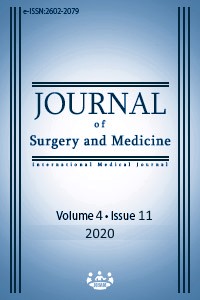Spatiotemporal relationship analysis of the 2019-nCoV patients hospitalized in Istanbul: A retrospective database analysis
Keywords:
Spatio-Temporal Relationship Analysis, 2019-nCoV, CountiesAbstract
Aim: The COVID-19 epidemic has reached every country in the world. Control strategies require effective tracing and isolation activities. Electronic mapping techniques are used in the visualization of spreading characteristics of COVID-19. The Geospatial Information System became an exceedingly popular open web tool to inform professionals and the public. These systems allow public health authorities to monitor the spreading characteristics and plan effective control strategies. The objective of this study was to identify the spatiotemporal mutual relationship of COVID19 patients living in two of the biggest districts of Istanbul (Kadikoy and Uskudar) who were admitted to the hospital. Methods: A total of 672 adult patients who were diagnosed with possible or confirmed COVID19 infection were included in the analysis. COVID19 diagnosis was confirmed either with positive RT-PCR test or radiographic chest imaging plus the presence of symptoms of the infection. Pearson correlation analysis and Moran’s correlation analysis were applied to the data set. Small pieces of regions [100,000 x 100,000] were set for the districts, and each event origin was fitted into the proper region using cartesian coordinate information. Getis-Ord hot spot analysis was performed to pinpoint the infections with higher concentration over time. Results: Pearson’s correlation revealed no significant results, while Moran’s analysis showed a significant correlation between distance and admission date [I: 0.64]. We identified at least 10 relevant hot spots in 3 districts. Conclusion: Determining the spatiotemporal relationship among cases of a central hospital may inform local authorities about dissemination patterns and help improve control measures against epidemics.
Downloads
References
WHO Coronavirus Disease (COVID-19) Dashboard. https://covid19.who.int/ Access 07.05.2020.
Koch T. 1831: The map that launched the idea of global health. Int J Epidemiol. 2014; 43:1014-20.
Zhou C, Su F, Pei T, Zhang A, Du Y, Luo B, et al. Covid-19: challenges to GIS with big data. Geography and Sustainability. 2020 Mar;1:77-87.
Bull SE, Briddon RW, Sserubombwe WS, Ngugi K, Markham PG, Stanley J. Genetic diversity and phylogeography of cassava mosaic viruses in Kenya. J Gen Virol. 2006 Oct; 87:3053-3065.
Kauhl B, Heil J, Hoebe CJ, Schweikart J, Krafft T, Dukers-Muijrers NH. The spatial distribution of hepatitis C virus infections and associated determinants -an application of a geographically weighted poisson regression for evidence-based screening interventions in hotspots. Plos One. 2005 Sep;10(9).
Wang L, Xing J, Chen F, Yan R, Ge L, Qin Q, et al. Spatial analysis on hepatitis C virus infection in mainland China: from 2005 to 2011. Plos One. 2014;9(10).
Daw MA, Buktir Ali LA, Daw AM, Sifennasr NEM, Dau AA, Agnan MM, et al. The geographic variation and spatiotemporal distribution of hepatitis C virus infection in Libya: 2007-2016. BMC Infect Dis. 2018 Nov;18(594).
Venna SR, Tavanaei A, Gottumukkala RN, Raghavan VV, Maida AS, Nichols S. A novel data-driven model for real-time influenza forecasting. IEEE Access. 2019;7:7691-701.
Kamel Boulos MN, Geraghty EM. Geographical tracking and mapping of coronavirus disease COVID-19/severe acute respiratory syndrome coronavirus 2 [SARS-CoV-2] epidemic and associated events around the world: how 21st century GIS technologies are supporting the global fight against outbreaks and epidemics. Int J Health Geogr. 2020 Mar;19(8).
Guner R, Hasanoglu I, Aktas F. COVID-19: Prevention and control measures in community. Turk J Med Sci. 2020 Apr; 50(3):571-577.
Kass RE, Caffo BS, Davidian M, Meng XL, Yu B, Reid N. Ten simple rules for effective statistical practice. Plos Comput Biol. 2016;12(6).
Moran PAP. Notes on continuous stochastic phenomena. Biometrika. 1950;37:17-23.
Getis A, Ord JK. The analysis of spatial sssociation by use of distance statistics. Geographical Analysis. 1992;24:189-206.
Florian C. A history of mathematical notations. New York: Cosimo Inc.; 1929.
Gravetter FJ, Wallnau LB. Statistics for the behavioral sciences. Belmont: Wadsworth – Thomson Learning; 2000.
Lloyd C. Spatial data analysis: an introduction for GIS users. Oxford: Oxford university press; 2010.
McGraw-Hill Concise Dictionary of Modern Medicine. https://medical-dictionary.thefreedictionary.com/hot+spot. Access 07.08.2020.
Chakravorty S. Identifying crime clusters: the spatial principles. Middle States Geographer. 2018;28:53-8.
Sánchez Martín JM, Rengifo Gallego JI, Blas Morato R. Hot spot analysis versus cluster and outlier analysis: An enquiry into the grouping of rural accommodation in extremadura (Spain). Int J Geo-Inf. 2019;8(176).
Protests over responses to the COVID-19 pandemic. https://en.wikipedia.org/w/index.php?title=Protests_over_responses_to_the_COVID-19_pandemic&oldid=958106480. Access 23.05.2020.
Yang W, Deng M, Li C, Huang J. Spatio-temporal patterns of the 2019-nCoV epidemic at the county level in Hubei province, China. Int J Environ Res Public Health. 2020;17(7):2563.
Zhifeng J, Feng A, Li T. Consistency analysis of COVID-19 nucleic acid tests and the changes of lung CT. J Clin Virol. 2020 Jun;127.
Downloads
- 381 801
Published
Issue
Section
How to Cite
License
Copyright (c) 2020 Bengü Şaylan, Doğus Özkan
This work is licensed under a Creative Commons Attribution-NonCommercial-NoDerivatives 4.0 International License.
















